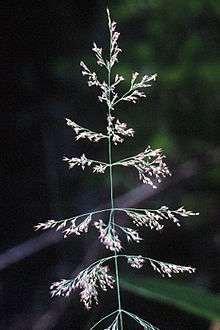Calamagrostis canadensis
| Bluejoint | |
|---|---|
 | |
| Scientific classification | |
| Kingdom: | Plantae |
| (unranked): | Angiosperms |
| (unranked): | Monocots |
| (unranked): | Commelinids |
| Order: | Poales |
| Family: | Poaceae |
| Genus: | Calamagrostis |
| Species: | C. canadensis |
| Binomial name | |
| Calamagrostis canadensis (Michx.) P.Beauv.[1] | |
| Varieties | |
|
List source : [2] | |
| Synonyms | |
| |
Calamagrostis canadensis is a species of grass, having three or more varieties, in the Poaceae family. It is known variously by the common names of bluejoint, bluejoint reedgrass, marsh reedgrass, Canadian reedgrass, meadow pinegrass, and marsh pinegrass.[7]
Varieties
Calamagrostis canadensis takes the form of at least three varieties, including the type.[2] The U.S. Forest Service names others.[7]
- The type variety (and autonym), is C. c. var. canadensis. This is the name for C. canadensis after varieties of it were named, and is used only to differentiate it from the other, newer varieties. The common name is bluejoint[4]
- C. c. var. langsdorffii. It is also called bluejoint.[5]
- C. c. var. macouniana. It is known as Macoun's reedgrass.[6] It was named for Canadian Botanist James Melville Macoun.[8]
Distribution
The varieties often overlap in where they are distributed.[2]
In the U.S.
Most states in the U.S. have one or more varieties of C. canadensis, the most common by distribution being C. c. var. canadensis. Only Minnesota, New Hampshire, New York, and Vermont have all three; and only one, Kentucky, has C. c. var. macouniana with no others.[4][5][6]
15 states have only C. c. var. canadensis, without others (Arizona, Delaware, Idaho, Indiana, Kansas, Maryland, Maine, North Carolina, Nevada, New Mexico, Rhode Island, Tennessee, Utah, West Virginia, and Wyoming); and no state has C. c. var. langsdorffii without sharing territory with C. c. var. canadensis.[4][5]
14 states have both C. c. var. canadensis and C. c. var. macouniana, without C. c. var. langsdorffii (Connecticut, Iowa, Illinois, Massachusetts, Mississippi, Missouri, North Dakota, Nebraska, New Jersey, Ohio, Pennsylvania, South Dakota, Virginia, and Wisconsin); and only seven have both C. c. var. canadensis and C. c. var. langsdorffii, and no C. c. var. macouniana (Alaska, California, Colorado, Georgia, Montana, Oregon, and Washington)[4][5][6]
In Canada and elsewhere
All three varieties are native to parts of Canada: the provinces of Alberta, Manitoba, Northwest Territories, Ontario, Quebec, Saskatchewan have all three varieties; British Columbia, Labrador, Newfoundland, and Yukon Territory have both C. c. var. canadensis and C. c. var. langsdorffii; New Brunswick, Nova Scotia, and Prince Edward Island have both C. c. var. canadensis and C. c. var. macouniana; and only Nunavut is the home of just one variety, C. c. var. langsdorffii.[4][5][6]
Two other places have varieties of C. canandensis, though neither have C. c. var. macouniana: Greenland has C. c. var. langsdorffii; and the French territorial islands of Saint-Pierre and Miquelon have C. c. var. canadensis[4][5]
Habitat
C. canadensis can be found in many types of habitat, including forest, taiga, and tundra in subarctic regions. It is the most common and widespread Calamagrostis species on the continent.[7]
Description
It is a perennial grass with a branching stem reaching heights between 60 centimeters and 1.5 meters. The flat, drooping leaves are rough with tiny hairs. The inflorescence is up to 25 centimeters long and may be open and loose or narrow and densely packed with spikelets. Each spikelet is about half a centimeter long and purplish in color.
It is a palatable food plant for livestock and wild grazing animals. It is a tough rhizomatous grass that provides soil stability in wet areas and is one of the first plants to reestablish on sites of recent oil spills.[7] It can be a nuisance on sites of forest restoration, because it can outcompete conifer seedlings.[7]
References
- 1 2 Palisot de Beauvois' treatment of Michaux's Arundo canadensis, which he placed under the genus Calamagrostis, was published in Essai d'une Nouvelle Agrostographie; ou Nouveaux Genres des Graminées; Avec Figures Représentant les Caractéres de tous le Genres. Imprimerie de Fain 157 (15, 152). 1812. Paris. "Plant Name Details for Calamagrostis canadensis". IPNI. Retrieved August 10, 2010.
basionym: Arundo canadensis. Remarks: Reference to the basionym is made on p. 152 (indirect).
- 1 2 3 "Profile for Calamagrostis canadensis (bluejoint)". PLANTS Database. USDA, NRCS. Retrieved August 11, 2010.
- ↑ Arundo canadensis was originally described and published in Flora Boreali-Americana (Michaux) 1: 73. 1803. "Plant Name Details for Arundo canadensis". IPNI. Retrieved August 10, 2010.
Distribution: Canada
- 1 2 3 4 5 6 7 "Profile for Calamagrostis canadensis var. canadensis (bluejoint)". PLANTS Database. USDA, NRCS. Retrieved August 11, 2010.
- 1 2 3 4 5 6 7 "Profile for Calamagrostis canadensis var. langsdorffii (bluejoint)". PLANTS Database. USDA, NRCS. Retrieved August 11, 2010.
- 1 2 3 4 5 "Profile for Calamagrostis canadensis var. macouniana (Macoun's reedgrass)". PLANTS Database. USDA, NRCS. Retrieved August 11, 2010.
- 1 2 3 4 5 Tesky, Julie L. (1992). "Calamagrostis canadensis". Fire Effects Information System (online). Rocky Mountain Research Station, Fire Sciences Laboratory (Producer): U.S.D.A; Forest Service. Retrieved August 12, 2010.
- ↑ George Vasey. A new Grass. 1885. Botanical Gazette. volume 10. page 297. (as Deyeuxia macouniana Vasey)